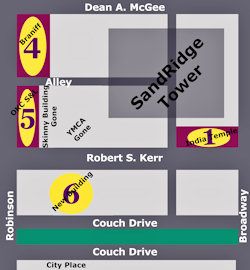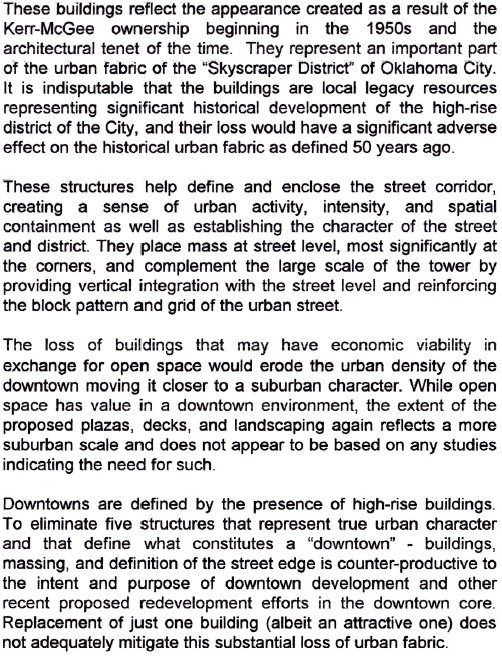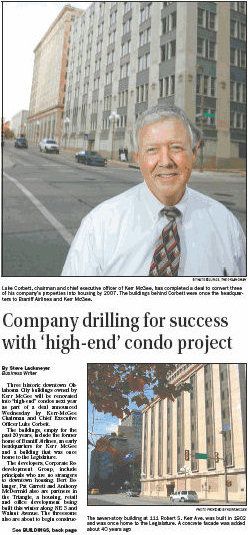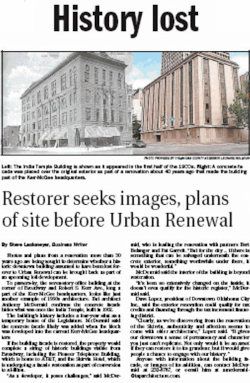| Some, on both sides of the SandRidge Commons proposal, advocate an all or nothing position. But ... WHAT IF it doesn't have to be one way or the other? What about Door #3 which might satisfy both (1) SandRidge's legitimate wishes to improve its campus, and (2) the "other side" which basically consists of (a) historical preservationists and (b) those wanting to preserve either or both of the Robinson and/or Broadway "urban wall"? Is there another way — a Door #3? |
The public hearing before the Board of Adjustment comes up less than 48 hours after this article is initially written. As has been previously noted, the Board of Adjustment has several options — as do the adversaries, SandRidge Energy and Preservation Oklahoma.
One option, and one which requires the open minds of both contestants as well as the Board of Adjustment, is compromise. This article explores one such possibility.
In the maps below, buildings are numbered based upon their chronological seniority, the oldest being #1, the newest #6 (except that one could say that #3, the 11-story skinny building should be #5 or #6 since that building was constructed in 1957 -- I've used #3 since a small 2-story building was built on that space much earlier, the city's 2nd Culbertson building built in the early 1920s. At the left below, SandRidge wants to demolish all buildings except for the Braniff Building, #4; the appeal advocates preservation of each and all of those buildings. At the right, below, another possibility is presented — the Oklahoma City Savings & Loan (#5) and the India Temple (#1) would be preserved, but the 2 buildings immediately east of Oklahoma City Savings & Loan (#3 & #2) — the "skinny" building and the YMCA — and the Petroleum Club building (#6) would be permitted to be destroyed in exchange for SandRidge's promise to construct the new building on that same property that its plan proposes to build on the Petroleum Club building property. Click the images for larger views.
 |  |
On the west side of SandRidge's proposal, except for an open expanse fronting Robinson, SandRidge winds up with a huge amount of "clear" space to develop the gardens and public use areas that it proposes, as well as the new building which would take the place of the Petroleum Club building immediately south of its main campus. Opponents wind up getting to preserve the "urban wall" elements they want along Robinson and Broadway as well as the most historically significant building of all those which are involved, the India Temple.
Beyond that, SandRidge potentially gains an overwhelming amount of public support, including its opponents; "urbanists" keep their "urban walls;" and historical preservationists keep the main elements of their quest for preserving vintage Oklahoma City.
Is this a fair compromise?
Extreme positions on either side may say, "No — we want all or nothing." Let's have a look at both of those positions.
SANDRIDGE PERSPECTIVE. SandRidge maintains that it wants to create a magnificent public area development which highlights its campus east and west between Robinson and Broadway and north and south from Couch Drive to Robert S. Kerr. It maintains that this development would be great for the city, as well as to SandRidge, and its architectural drawings are, quite clearly, very impressive. Implicitly, its position inheres in the notion that what the proposal presents its position that there is much more to be gained by the city than what the city would stand to lose.
OPPONENTS PERSPECTIVE. Opponents are not all of the same mind ... some are what I'll call "urbanists" and others are what I'll call "historical preservationists." For purposes of the appeal to the Board of Adjustment, all opponents can be fairly dumped into the same bucket. In the appeal, opponents want to preserve everything that SandRidge wants to destroy, for various reasons. Some opponents are concerned about the "urban walls" which would be destroyed along Broadway, but most particularly along Robinson. Many of them are not pleased about the suburban developments which, for example, have been allowed along Walker, a suburban garden-apartment development between Kerr and McGee. Other opponents are equally or more concerned about the destruction of Oklahoma City's history during a time that the 400+ destruction of downtown buildings during the city's Urban Renewal period which is not out of sight or or out of mind. Opponents are united in their claim that they have a stake, and a share, in what and how SandRidge proposes to do with the property that it clearly owns.
WHO IS RIGHT? The answer to that question obviously involves subjective opinions. This article doesn't attempt to answer that question, except as to its fringe components, but instead looks to find a way to forging a common ground.
LOOKING AT THE PIECES. While opponents to the SandRidge Commons proposal will necessarily and reasonably differ since their respective "bottom lines" are not the same, here is my take about the pieces and why compromise is desirable and for the good of all concerned.
- India Temple. In the above maps, India Temple is identified as building #1 — that's because it is the oldest of the buildings, and, in fact, is the oldest remaining building downtown and has a venerable history. I've not taken a poll, but my guess is that most "preservationists" would see this building as the highest item on their list of priorities.
- Oklahoma City Savings & Loan. This is building #5 in the above maps. My guess is that historical preservationists would see the is the 2nd most item on their list of priorities. But "urbanists" would probably place it as #1 on the list of buildings which should be preserved since it fronts on Robinson and forms a part of what they call the "urban wall" along Robinson, and that Robinson urban wall is the focus of their approach.
- The Skinny Building. The 1956-1956 11-story "skinny building" to the immediate east of the Oklahoma City Savings & Loan building isn't even "historic," at least as I would define that term. It was built in 1956-57 to fill the gap between the OKC S&L building on the west and the YMCA building on the east, the earlier 2-story building in that space having been destroyed in the process and which no longer exists. From a SandRidge perspective, this building impedes the corporate campus development. As a preservationist, which label I adopt, this one's not historically significant. If a compromise along the lines of what I'm suggesting develops, this building is expendable.
- YMCA. The venerable 1918 YMCA building, totally remodeled by Kerr-McGee, is the 3rd-most hardest for me to let go of. But, from SandRidge's perspective, it is probably the most intrusive into the space that SandRidge wants to use for its SandRidge Commons proposal since it lies immediately southwest of the SandRidge Tower. From a preservationist's perspective, while it is a dear building, it is most probably beyond the point that it could be restored to its original configuration in any meaningful sense. Hence, for compromise purposes, it can be let go.
- Petroleum Building. This 1957 building does present a unique architectural downtown building style and does contain a historic high-rise passage between that building and the present-day City Place, 14-15 stories up in the air. In SandRidge's proposal, the destruction of this building is unique — in this space, SandRidge actually proposes to build a new citizen-friendly building. In the spirit of compromise, I'm inclined to let SandRidge have its way, assuming that its promise for the new building is kept.
SPURIOUS ARGUMENTS. While a rational and sensible position can be reasonably argued by each of the adversaries, some arguments strike me as weaker and less legitimate than others.
- The buildings are junk and are eyesores. While that may be a matter of opinion, at least as late as 2005-2006 neither Kerr-McGee nor other local investors thought so. A pair of Oklahoman articles below reported on what Kerr-McGee then thought and comments made by what would have been investors to buildings #1 (India Temple), #4 (Braniff), and #5 (Oklahoma City Savings & Loan. Click the thumbnails to read the full articles.
- SandRidge Energy, as property owner, should be allowed to do what it wants. While that may seem a fair thing to say on first blush, no reasonably informed person can advocate that premise with a straight face. In a municipality, property owners always have layers of restrictions and conditions imposed upon them. In a residential area, ordinances concerning use and structures much be complied with. In historical preservation neighborhoods, restrictions and requirements go well beyond that. In the downtown situation, the Staff Report which disfavored most of SandRidge's proposal cited the following ordinance as the basis for its objection:

Except for the Petroleum Club building, the Staff Report concluded that SandRidge's proposal did not comply with the foregoing ordinance, as follows:

The point is, SandRidge does not have carte blanch authority to do what it wants with its downtown properties. Whether its proposal is in compliance with the cited section from the city's municipal code, above, is an issue which will be decided by the Board of Adjustment.
Related articles:
- Appeal by Preservation Oklahoma
- SandRidge Proposal -- What Have We Got To Lose?
- Hugging Our SandRidge Buildings
- Bye Bye Miss American Pie
- National Trust For Historic Preservation Weighs In
- SandRidge Commons - Round 2
- SandRidge - Holder of a Legacy
- SandRidge & Restoration
















No comments:
Post a Comment